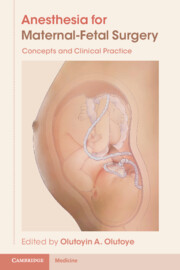Book contents
- Anesthesia for Maternal-Fetal Surgery
- Anesthesia for Maternal-Fetal Surgery
- Copyright page
- Dedication
- Contents
- Contributors
- Abbreviations
- Preface
- Acknowledgments
- Section 1
- Section 2
- Section 3
- Chapter 10 Myelomeningocele Repair
- Chapter 11 Lung Masses
- Chapter 12 Sacrococcygeal Teratoma
- Chapter 13 Ex-Utero Intrapartum Therapy
- Index
- Endmatter
- References
Chapter 11 - Lung Masses
from Section 3
Published online by Cambridge University Press: 19 November 2021
- Anesthesia for Maternal-Fetal Surgery
- Anesthesia for Maternal-Fetal Surgery
- Copyright page
- Dedication
- Contents
- Contributors
- Abbreviations
- Preface
- Acknowledgments
- Section 1
- Section 2
- Section 3
- Chapter 10 Myelomeningocele Repair
- Chapter 11 Lung Masses
- Chapter 12 Sacrococcygeal Teratoma
- Chapter 13 Ex-Utero Intrapartum Therapy
- Index
- Endmatter
- References
Summary
Prenatally diagnosed congenital lung malformations represent a wide variety of fetal pulmonary and airway anomalies, some of which may require close monitoring and perinatal follow-up. Historically these masses were only typically seen when they were very large, at which point they were associated with a high incidence of hydrops and a high termination rate; therefore a diagnosis of a fetal lung mass had a guarded prognosis. Widespread use of prenatal ultrasound improved detection of these masses and advances in surgical techniques have allowed for intervention in the fetal period. More recently, a better understanding of fetal physiology and the use of prenatal steroids has reduced the number of fetuses requiring in-utero intervention. When indicated, in-utero treatment requires a multidisciplinary approach with close attention given to the fetal physiology, risk of maternal complications, and unique anesthetic considerations.
Keywords
- Type
- Chapter
- Information
- Anesthesia for Maternal-Fetal SurgeryConcepts and Clinical Practice, pp. 152 - 167Publisher: Cambridge University PressPrint publication year: 2021

